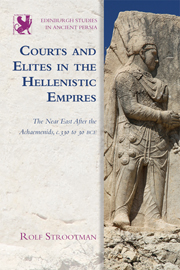Book contents
- Frontmatter
- Contents
- List of Illustrations
- Acknowledgements
- Abbreviations
- The Hellenistic Dynasties
- Series Editor's Preface
- Map
- Introduction: Court and Empire in the Hellenistic Near East
- PART I SETTING THE SCENE
- 1 The Court as an Instrument of Power
- 2 The Theatre of Royalty
- 3 The Royal Palace: A Stage for Royal Rituals
- PART II THE COURT AS A SOCIO-POLITICAL SYSTEM
- PART III CEREMONIAL AND RITUAL
- Conclusion
- Bibliography
- Index
2 - The Theatre of Royalty
from PART I - SETTING THE SCENE
Published online by Cambridge University Press: 05 September 2014
- Frontmatter
- Contents
- List of Illustrations
- Acknowledgements
- Abbreviations
- The Hellenistic Dynasties
- Series Editor's Preface
- Map
- Introduction: Court and Empire in the Hellenistic Near East
- PART I SETTING THE SCENE
- 1 The Court as an Instrument of Power
- 2 The Theatre of Royalty
- 3 The Royal Palace: A Stage for Royal Rituals
- PART II THE COURT AS A SOCIO-POLITICAL SYSTEM
- PART III CEREMONIAL AND RITUAL
- Conclusion
- Bibliography
- Index
Summary
In their outward show of majesty, they were like actors on a stage.
Plutarch, Life of Demetrios 41.3Whenever a Seleukid or Ptolemaic king appeared in public he appeared both as man and as the incarnation of royalty, with all the appropriate signs of power and authority. Clothing, weapons, objects and iconography represented aspects of kingship. Kings were furthermore permanently accompanied by a retinue of philoi, guardsmen and other members of the royal entourage. Plutarch describes, as a negative mirror image of the sober Roman rulership he favoured, how in the Hellenistic kingdoms it was quintessentially royal to be surrounded ‘by a profusion of purple robes and mantles, [and] a throng of messengers and door-keepers’. When the Athenians welcomed Demetrios Poliorketes, they sang how ‘his friends surround him like stars around the sun’ (see below). The number of philoi gathering around the king, each with his own status and reputation, was a sign of how much a ruler was held in esteem by great men; conversely, the prestige of the king reflected on those who stood by his side.
The presence of a large crowd surrounding the ruler to strike awe into visitors is a typical facet of the monarchical rituals at many courts in history. Grand viziers of the Ottoman sultans received foreign ambassadors on Fridays, when the palace personnel received their salary and the central court of Topkapı Palace was crowded with people. In 1526 an ambassador of the Habsburg emperor wrote of the court of Vassili III: ‘The presence of so many people on such a day arises from two causes: so that foreigners may note the size of the crowd and the mightiness of its lord and also that vassals may note the respect in which their master is held.’
- Type
- Chapter
- Information
- Courts and Elites in the Hellenistic EmpiresThe Near East After the Achaemenids, c. 330 to 30 BCE, pp. 42 - 53Publisher: Edinburgh University PressPrint publication year: 2014



